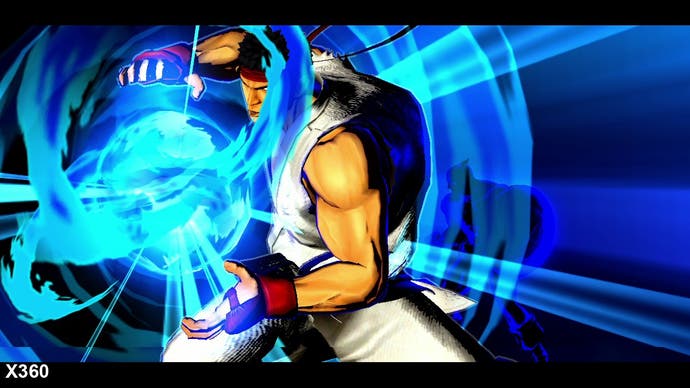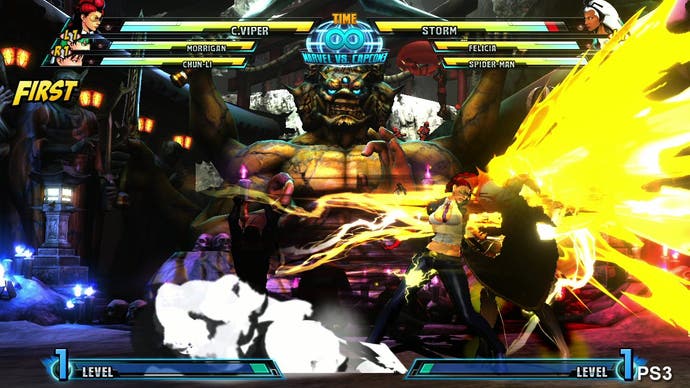Xbox 360 vs. PlayStation 3: Round 29
Marvel vs. Capcom 3, Test Drive Unlimited 2, Fight Night Champion, Stacking, de Blob 2.
All killer, no filler - there are five top-rated titles in this instalment of our ongoing Xbox 360 vs. PlayStation 3 comparison comparison, covering off the cream of the crop from the latest cross-platform releases.
It's a huge article backed up by hundreds of supplementary screenshots alongside 11 high-definition videos, so let's move swiftly along to the line-up, complete with handy links to get you to the right page and the right game as quickly as possible.
- Marvel vs. Capcom 3: Fate of Two Worlds
- Stacking
- Test Drive Unlimited 2
- de Blob 2
- Fight Night Champion
Coming up soon on Digital Foundry, we'll be taking a look at Dragon Age II on console and PC formats before moving on to THQ's Homefront.
Many thanks to David Bierton and Alex Goh for their contributions to this piece.
Marvel vs. Capcom 3: Fate of Two Worlds
| Xbox 360 | PlayStation 3 | |
|---|---|---|
| Disc Size | 2.8GB | 3.16GB |
| Install | 2.8GB | 1497MB (mandatory) |
| Surround Support | Dolby Digital | Dolby Digital, 5.1LPCM |
It's been a 10-year wait for Marvel vs. Capcom 3: Fate of the Worlds to finally arrive, but thankfully it's been worth it. Capcom's latest may well have a simplified control system and a reduced (though still plentiful) cast of heroes and villains, but beneath the accessible veneer is the kind of depth we would expect from a top-tier fighting game by the acknowledged masters of the genre.
As with Street Fighter IV, MVC's return demonstrates that fighting games can still be relevant and popular. However, unlike SFIV, outside of the core gameplay this release isn't quite as impressive in terms of the complete package on offer. It lacks much in the way of the extra modes and additional options which came as standard in both vanilla and Super versions of SFIV, and as such sometimes feels a little empty in comparison.
It's fair to say that Capcom has done a great, if not completely exceptional job with the actual game as a whole, but how does the game stack up as a multi-platform release?
As with Super Street Fighter IV, there's not a whole lot in it, with only a few, very minor graphical differences separating the Xbox 360 and PlayStation 3 releases. The jump from Street Fighter's custom engine to the use of the MT Framework setup has tangible benefits for the graphical make-up of the game, while also unifying the development toolset across a even greater range of titles for the developer.
MVC3 renders in 720p on both platforms, but neither exhibits any form of anti-aliasing. Previously, for both iterations of Street Fighter IV, the 360 game benefited from the use of 2xMSAA, while the PS3 version had no anti-aliasing at all. Due to the make-up of the artwork, combined with the way that the human eye blends high frame-rate action, the difference was negligible and the omission wasn't such a big deal. In the case of MVC3, aliasing is only apparent in higher-contrast areas, or in stages with plentiful amounts of more finely detailed structures.




During pre-fight sequences and the execution of hyper combos, we also see that the 720p rendering resolution is maintained on both platforms no less (in contrast to the original Street Fighter IV). However, given the heavier requirements on memory consumption and bandwidth, something else besides anti-aliasing had to give.
With MVC3, Capcom has chosen to render some of the game's visual effects in a lower resolution. The main elements that seem to be affected are the various fire effects used in explosions, and on some of the various pyrotechnics when special moves collide with their intended target. As you can see below, the result is that there is some artifacting around the characters when the effects overlap with the higher-resolution character models - an inevitable consequence of blending with a low-res alpha buffer.
Other effects also are pared back in this way, but not all. Many still seem to be rendering at full res, or at least close to that, for the most part, with some looking poorer due to being upscaled at various points. In any case, the game's smooth 60FPS update and fast-paced nature makes these small instances fly by without impacting on the look of the game.
So far, in terms of the whole graphical make-up of the game, everything has been built around carefully achieving, and indeed constantly keeping a 60FPS update. The lightning-fast controller response time that such a frame-rate provides is absolutely paramount to the experience. The question is, can the developer sustain that all-important 16ms refresh on both platforms?
It's virtually impossible to demonstrate anything resembling like-for-like gameplay in a fighting game of this nature, so instead of the usual head-to-head performance analysis video we've taken a different approach. Here we have a series of matches taken from our initial fumblings in Arcade Mode, giving you an impression of how the game performs across the run of play. We'll kick off with the Xbox 360 version.
As with the previous MT Framework titles we've seen on the Microsoft console, Capcom has adopted a double-buffered approach. The renderer displays one frame while calculating the next, then flips the framebuffer. If a frame runs over budget, the switch in buffers occurs during refresh, resulting in screen-tear. As you can see, only the insane Hyper moves and occasional team attack cause any kind of issue for the Xbox 360 version of the game; otherwise we see a full-fat 60FPS experience.
For the PlayStation 3 version of Marvel vs. Capcom 3, we also see similarities with previous MT Framework titles in the way the framebuffer is handled, resulting in a different performance profile.
MVC3 is v-synced on the PS3 - frame-rate is lower in busy areas, but there is no tearing whatsoever. Hyper moves and tag-team crossovers are the common cause for frame-rate dips and the drops in the intro scenes are especially noticeable.
The implementation of v-sync sees tearing completely removed from the experience, but it comes at a cost. On 360, the framebuffer flips mid-refresh, resulting in screen-tear, but it does ensure that the latest action to be processed internally is displayed as quickly as possible. With PS3, the game waits until the refresh is complete before updating the screen, resulting in the game effectively stalling in the mean time.

